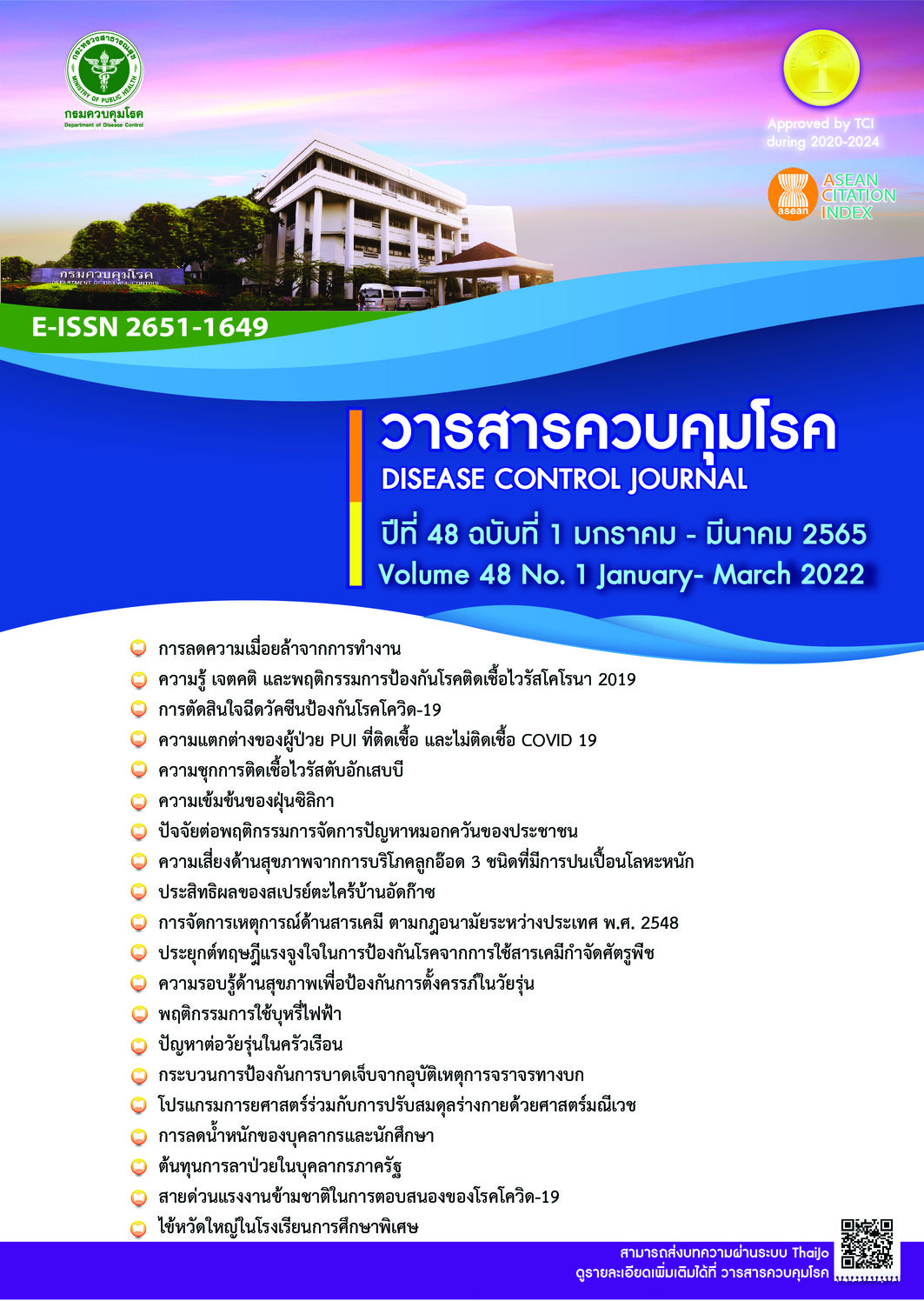Evaluation of chemical events management following International Health Regulations, 2005: IHR (2005) in provinces located in Special Economic Zone (SEZ) and Border Health Provinces (BHPs)
DOI:
https://doi.org/10.14456/dcj.2022.10Keywords:
International Health Regulations, Chemical events management, Special Economic Zone, Border Health ProvinceAbstract
Chemical events management was a technical area of Joint External Evaluation (JEE) tool used to prevent, control, and respond to diseases and health hazards in accordance with the International Health Regulations 2005, or IHR (2005). The Department of Disease Control (DDC), Ministry of Public Health (MOPH) has expanded its activities to the provincial level, including the provinces located in the Special Economic Zone (SEZ) and Border Health Provinces (BHPs). This cross-sectional descriptive study aimed to evaluate the implementation of IHR (2005) core capacity in chemical events-related issues, analyze barriers to implementing the program at the provincial level, and provide recommendations for health authorities in SEZ and BHPs. The data were collected by using IHR (2005) JEE tool intended for implementation at the provincial level, of which contents covers technical area 18 - chemical events assessment. This data collection form was developed by DDC for use in 27 provinces. Data were analyzed and interpreted using assessment criteria with descriptive statistics and content analysis. The results found that (1) most of provinces in SEZ and BHPs had no capacity in chemical event management (33.3%), followed by those with demonstrated capacity level (22.2%), moderate capacity level (18.5%), limited capacity level (14.8%), and sustainable capacity level (11.1%). As for the first three activities which were successfully completed, 70.4% of participating provinces have established chemical accident risk database, 66.7% of them have conducted exercise on chemical emergency response at the provincial level, and 66.7% of them have provided a refresher course on the knowledge of chemical events to their respective provincial SRRT team. On the contrary, the first three activities which had yet to be conducted included human resource development plan or training courses related chemical events (51.9% of provinces participating in the study), chemical risk area assessments (48.2%), and integration and standardization of existing Standard Operating Procedures (SOPs) for chemical sampling and delivery for laboratory analysis (44.4%). Additionally, provinces located in the SEZ and BHPs have encountered various operational problems, including an incorrect and incomplete area according to the IHR (2005) – JEE tool, limitations on personnel, resources, and insufficient budget. Therefore, more efforts should be made by the DDC so as to translate the policy into actions with particular emphasis on interagency cooperation, personnel allocation and budget, continued implementation of personnel capacity building program, and monitoring and evaluation (M&E). For provincial level, there should be a clear set of responsibilities, preparations of work plans according to IHR 2005, and cooperation with their local network.
Downloads
References
Department of Disease Control. International Health Regulations (2005). Nonthaburi: Bureau of Epidemiology; 2018. (in Thai)
Bureau of Epidemiology. Questions and answers about International Health Regulations 2005 the guideline for the implementation of International Health Regulations 2005 for administrator and practitioner. Nonthaburi: The Agricultural cooperative federation of Thailand; 2014. (in Thai)
Bureau of Academic, the Secretariat of the House of Representatives. International Health Regulations 2005 [Internet]. 2016. [cited 2020 Sep 30]. Available from: https://dl.parliament.go.th/backoffice/viewer2300/web/viewer.php (in Thai)
Department of Disease Control. 20-Year National Strategic Plan for Disease Prevention and Health Hazards (2017 - 2036). Nonthaburi: Department of Disease Control; 2017. (in Thai)
World Health Organization. Joint external evaluation of IHR core capacities of the Kingdom of Thailand Mission report: June 26-30, 2017. New Delhi: World Health Organization, Regional Office for South-East Asia; 2018.
Department of Disease Control. 5-year Strategic action plan (2017 - 2021) Department of Disease Control fiscal year 2018 [Internet]. 2018. [cited 2020 Sep 30]. Available from: http://plan.ddc.moph.go.th/meeting30_1augsep/meetting30_1/page1.html
Bureau of Strategic and Planning, Ministry of Public Health. Health expenditure of migrant population in 31 border provinces in fiscal year 2015. Nonthaburi: Bureau of Strategic and Planning; 2016. (in Thai)
Division of Occupational and Environmental Diseases. Annual report in fiscal year 2019. Bangkok: Aksorn graphic and design publishing house LP; 2020. (in Thai)
Department of Disease Control. Guidelines for assessment 19 activities according to IHR-JEE in provincial level. Nonthaburi: Division of Epidemiology; 2018. (in Thai)
Chaipromkhieo N, Prutipinyo C, Usathaporn S, Sirichotiratana N. Public health emergency of international concern prevention and control measures: a case study on special economic development zone, Maesod border control, Tak province, Thailand. Public Health & Health Laws Journal 2017; 3(2): 193-210. (in Thai)
Bureau of Occupational and Environmental Diseases. National preparedness in target 4 chemical safety [Internet]. 2015. [cited 2020 Sep 30]. Available from: http://envocc.ddc.moph.go.th/uploads/situation/4%20Chemical.pdf (in Thai)
Downloads
Published
How to Cite
Issue
Section
License
Copyright (c) 2022 Disease Control Journal

This work is licensed under a Creative Commons Attribution-NonCommercial-NoDerivatives 4.0 International License.
Articles published in the Disease Control Journal are considered as academic work, research or analysis of the personal opinion of the authors, not the opinion of the Thailand Department of Disease Control or editorial team. The authors must be responsible for their articles.






